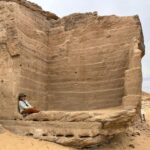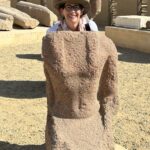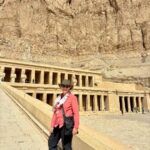An Interview With Archeologist and Writer, Kristin South
Photos of Kristin South in Fayum, Egypt



Welcome to my blog, Kristin. We are lucky to catch you before you head to Egypt next Friday.
KH: I’m happy to be caught!
NG: What made you become an archeologist?
KH: You can blame (or credit) the school library. I fell in love with Egypt when I was in sixth grade, after reading The Egypt Game and Mara, Daughter of the Nile. Also, The Blue Sword, which wasn’t about Egypt per se, but it made me so enchanted by the desert. I also met a real-life Egyptologist, the father of a friend of mine, and he mentored me through my high school years. By the time I graduated, I knew what I wanted to do, and I started learning to read hieroglyphs my first semester in college.
NG: What are the worst and best things about digging into the past?
KH: I want to answer your question literally and talk about my excavation work! I love digging. My trowel feels so comfortable in my hand that I described how to use one in loving detail in the first chapter of my middle-grade book set in Egypt. I love spending my days outside in the barren desert, discovering what’s beneath the shifting sands. I love quietly doing my work while listening to the Egyptian inspectors, guards, and other workers talk to each other in Arabic and trying to understand what they’re saying.
I don’t always love the weather, though. When I work on the dig in the winter months, there can be a bone-chilling cold, and in the summer the temperatures are often over 100 F (37.7 C). And it’s always very windy. I have to use giant clamps to keep my papers from flying around, and I often come home with sand in my hair and up my nose.
NG: What archeological questions might be answered on your trip to Egypt?
KH: When I’m on my dig, there are two types of work: when we are excavating new material, we have to keep careful track of every possible detail so that later researchers can use the data to answer whatever interests them. When I’m looking at previously collected data, including artifacts, I bring a specific question to my examination. This year I’m hoping to look at a bunch of reused articles of clothing and see what they can reveal about how items of clothing were mended and reused. I’m doing this work with my friend Anne Kwaspen, who is a specialist in textile analysis and conservation.
NG: When you’re in Egypt, do you plan on any fun dining or excursions (like a trip up the Nile😊)?
KH: I did that in March when I went to Egypt as a tour guide. I had the opportunity to take a four-day trip on a dahabiya, a wonderful boat that’s smaller than a cruise ship and larger than a regular sailboat. We visited sites from Aswan to Luxor, and I saw some less visited places that I’d never seen before, like a sandstone quarry that was used in ancient times to supply all the rock that was used to build the enormous temples at Karnak and Edfu and others. It’s really impressive to see the temples and the quantity of rock they needed to build them, and then to see how far the stone had to travel before they could use it!
NG: You are also a writer, and you contributed a wonderful article to the Writer’s Unboxed website (https://writerunboxed.com/2024/01/22/thin-places/) “Thin Places” explores the question of where (or how) writers get their ideas. Tell us a bit about how you think of this question.
KH: Thank you for mentioning that! Writers have to draw their stories from someplace, right? I like to think that many of the stories we write are plucked from an alternate dimension rather than simply made up. When I have visited places that have been venerated for centuries, like Angkor Wat or the Umayyad Mosque in Damascus, or even a national park like Bryce Canyon in southern Utah, it’s like the accumulation of human emotions and experience lay like a thick dust over the place. Sometimes we can collect a bit of that dust and blow it onto our keyboards, and amazing things result. I think that being in an unfamiliar place can make us look at everything more closely, so we see more than usual. I’m a big fan of travel.
NG: You write fiction for middle schoolers and have taught middle school. How do students respond to learning history through fiction?
KH: I used to assign one work of fiction each trimester when I taught eighth and tenth-grade history. Those were always the readings that students liked best and that they remembered when it came time for exams. The struggles of fictional characters feel real in a way that readings in a history textbook often do not. With vivid sensory detail and interesting conflicts and people we can recognize regardless of when or where they lived, fiction appeals in a way that nonfiction does not always attempt to do. I love that there are so many authors writing books for younger readers who strive for historical accuracy while also telling a great story. Laurie Halse Anderson, Kimberly Brubaker Bradley, and Ruta Sepetys are some of my recent favorites.
NG: You also write short stories and novels for adults. Do you find your protagonists or do they find you?
KH: The twelve-year-old archaeologist who is the protagonist for my middle-grade books set in Egypt came walking into my bedroom one day and stood in the corner with her arms folded, tapping her foot until I finally got out of bed and started taking notes. Most of the others haven’t been quite so insistent, but she has that personality and they don’t. 🙂 Often a few lines of dialogue can get me started, or an intriguing question or situation. I think I’m influenced by place more than anything, as that “Thin Places” article shows.
NG: You have lived in Connecticut and Utah, and now you live in Atlanta. Have a favorite place? One that inspires you?
KH: Anyplace where I can take a good long walk. Ideas fall into place for me on a walk better than in any other way.
NG: Thanks for your time, Kristin. May the sands of Egypt whisper to you on your coming trip.
- Readers can find Kristin’s website about Egypt for middle graders at: https://www.kristinhacken.com/
- Check out Kristin’s latest article for writers: https://writerunboxed.com/2024/04/25/in-praise-of-episodic-enthusiasm/
4 Comments
Submit a Comment



Thanks for this, Nancy! I looked at her essays and loved the one about “thin places.” That’s so Lily Scott, isn’t it? Are you part of writerunboxed? Looks like they have an Unconference in Salem? Reminds me of how we continue the “Faux Conference” at Craigville each August.
Hi Ann, You are so right about Kristin’s essays–especially thin spaces. I went to the Salem Unconference in Salem. It was delightful!!! And that Faux Conference in Craigville is such a comfort after making so many friends there!!! Craigville is what I’d call a “thin space.”
Nancy, your blogs are always interesting, featuring wonderfully unusual characters, like Kristin Hacken. And your decorative photo is beautiful!
Thanks, Erica. I’ve been so excited to interview Kristin!